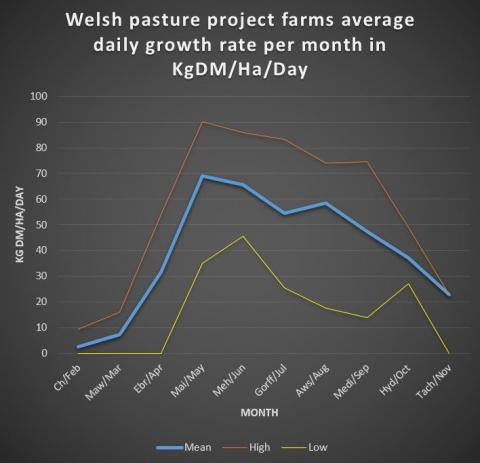6 farms have been providing weekly data on the grass growth of their farms and the management decisions undertaken as part of the Farming Connect Pasture Project. The aim of the project is to highlight the potential benefits of measuring grass on various farming systems and to offer a weekly real time tracker of grass growth at different altitudes and parts of the country.
Individual farm data can be viewed by clicking on the interactive map which shows the daily growth rate (KgDM/Ha/Day) and the average farm cover (KgDM/Ha). The graph below shows the average daily growth on the 6 farms on a monthly basis. Although there are similarities in the patterns and trends the graph highlights the range of growth between farms for the same period.
Knowing your farm’s growth rates and grass covers can help when it comes to decision making. A record of the previous year’s growth will also offer a useful insight into the potential yields of grass silage, stocking rates or where to target any sward improvements.
Every year and every weather front brings a different challenge to managing the growth of grassland and 2016 was no exception. By in large the growth of grass has been good throughout Wales. The cold start to the year was followed by a rapid period of daily growth and although the covers were there to be grazed early in the season the ground conditions did not allow for effective grazing or the fields were left damaged. It is vital that spring grass is grazed well early in the season which then sets a precedent for the rest of the season’s growth.
Bala
The effect of a recent wholesale reseeding programme was evident on the Bala site as the farm achieved some of the highest growth rates of the project (101 KgDM/Ha/Day) despite being one of the highest altitude sites on the project (640 ft). Rotation lengths of the grazing swards were reduced to 18 days during this peak growth.
Llanrwst
At 940ft the Llanrwst site saw no growth in their swards during the months of February to April with some growth in May and a peak in early June at 45.6 KgDM/Ha/Day. As with most sheep farms with similar topography the Llanrwst site used a limited amount of Nitrogen (20 Kg/Ha of N) during two application periods.
Llandeilo
At 66ft the Llandeilo site managed to achieve some of the highest covers during September at just over 2300 KgDM/Ha during the 2nd week of October. Careful management of high autumn covers is required when planning for the following spring’s grazing. A late cut of silage was taken in early October.
Haverfordwest
The highest daily growth of the whole project in 2016 was recorded on the Haverfordwest site during the third week of May. Important decisions were made during the following weeks with the pre mowing of some paddocks and a reduction in the rotation length of the swards to maintain quality and digestibility.
Caernarfon
Average farm cover peaked during the 1st week of May (2844 KgDM/Ha) with a peak in growth of just over a 100 KgDM/Ha/Day during the middle of April. This site was a good example of how grass growth in Wales spurted from only a few KgDM/Ha/Day to large volumes within a short time period.
Pwllheli
Grass covers were already in excess of 2300 KgDM/Ha at the beginning of the measuring period. The low altitude and warmer temperature meant the Pwllheli site was the earliest growing farm in the project with 16.1/Ha/Day for March. The end of June and early July saw a drop in the daily growth to 46 KgDM/Ha/Day which led to decisions regarding buffer feeding the cattle.
Measuring for 2016 has now come to an end and farmers taking part in the project will begin measuring grass in earnest again next spring. No new data will be added to the website until next February. New farms will be taking part in the project next spring to add to the range of locations and systems which will enable you to benchmark your own growth rates against the project farms.
Measuring the opening grass covers (Grass density at the beginning of the year) is essential as well as monitoring soil temperature and ground conditions before deciding on any fertilizer application to ensure efficient uptake of nutrients.
For more information or to take part in the project next spring please contact Rhys Davies on 07985379880

